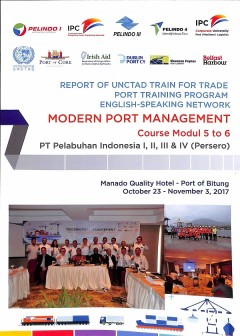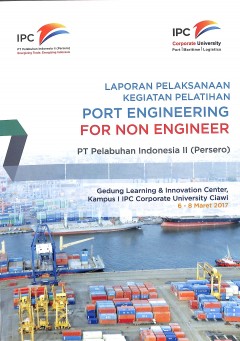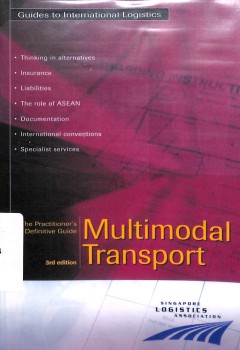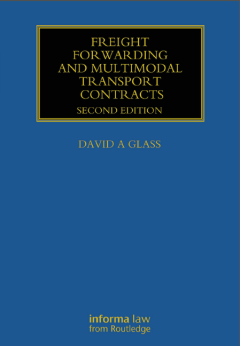Ditapis dengan

Multimodal Transport
- Edisi
- -
- ISBN/ISSN
- 978-981-248-182-5
- Deskripsi Fisik
- -
- Judul Seri
- -
- No. Panggil
- -
- Edisi
- -
- ISBN/ISSN
- 978-981-248-182-5
- Deskripsi Fisik
- -
- Judul Seri
- -
- No. Panggil
- -

Multimodal Transport
- Edisi
- -
- ISBN/ISSN
- 1-85044-894-9
- Deskripsi Fisik
- 583 p
- Judul Seri
- -
- No. Panggil
- SC TXT MUL r
- Edisi
- -
- ISBN/ISSN
- 1-85044-894-9
- Deskripsi Fisik
- 583 p
- Judul Seri
- -
- No. Panggil
- SC TXT MUL r

Syllabus : Transport Security
- Edisi
- Transport Security
- ISBN/ISSN
- -
- Deskripsi Fisik
- illus,; 30 cm
- Judul Seri
- -
- No. Panggil
- CC STC SYL t C1
- Edisi
- Transport Security
- ISBN/ISSN
- -
- Deskripsi Fisik
- illus,; 30 cm
- Judul Seri
- -
- No. Panggil
- CC STC SYL t C1

Transport Security
- Edisi
- Transport Security
- ISBN/ISSN
- -
- Deskripsi Fisik
- 64 page
- Judul Seri
- Transport Security
- No. Panggil
- CC STC MOD t C1
- Edisi
- Transport Security
- ISBN/ISSN
- -
- Deskripsi Fisik
- 64 page
- Judul Seri
- Transport Security
- No. Panggil
- CC STC MOD t C1

modern port management course modul 5 to 6 pt pelabuhan indonesia I, II, III …
- Edisi
- 2017
- ISBN/ISSN
- -
- Deskripsi Fisik
- 55 p.
- Judul Seri
- -
- No. Panggil
- IPC GUI MOD p C.1
- Edisi
- 2017
- ISBN/ISSN
- -
- Deskripsi Fisik
- 55 p.
- Judul Seri
- -
- No. Panggil
- IPC GUI MOD p C.1

Laporan pelaksanaan kegiatan pelatihan port engineering for non engineer PT p…
- Edisi
- 2017
- ISBN/ISSN
- -
- Deskripsi Fisik
- 19 p.
- Judul Seri
- -
- No. Panggil
- IPC REP 2017 POR p C.1
- Edisi
- 2017
- ISBN/ISSN
- -
- Deskripsi Fisik
- 19 p.
- Judul Seri
- -
- No. Panggil
- IPC REP 2017 POR p C.1

Modul port customer relation management 18 desember 2017
- Edisi
- 2017
- ISBN/ISSN
- -
- Deskripsi Fisik
- 1 eksemplar buku
- Judul Seri
- -
- No. Panggil
- IPC GUI MOD p C.1
- Edisi
- 2017
- ISBN/ISSN
- -
- Deskripsi Fisik
- 1 eksemplar buku
- Judul Seri
- -
- No. Panggil
- IPC GUI MOD p C.1

Modeling the Increased Complexity of New York City's Refuse Marine Transport…
The New York City Department of Sanitation operates the world's largest refuse marine transport system. Waste trucks unload their cargo at land-based transfer stations where refuse is placed in barges and then towed by tugboats to the Fresh Kills Landfill in Staten Island. In the early 1980s, the city commissioned the development of a computer-based model for use in fleet sizing and opera…
- Edisi
- J STOR
- ISBN/ISSN
- -
- Deskripsi Fisik
- 23 halaman
- Judul Seri
- Modeling the Increased Complexity of New York City's Refuse Marine Transport System
- No. Panggil
- ATC PO OCT a

Knowledge capture to inform sustainable maritime operations
Purpose - The purpose of this paper is to report an explicit taxonomy of maritime operations (MO) to guide Harbour Masters (HM)s of smaller ports in planning more sustainable operations. Design/methodology/approach – This research presents strategies for building theory to promote more sustainable port management in a two-stage research design. Starting from a base taxonomy in research stag…
- Edisi
- International Journal of Operations & Production M
- ISBN/ISSN
- -
- Deskripsi Fisik
- 25 halaman
- Judul Seri
- Knowledge capture to inform sustainable maritime operations
- No. Panggil
- ATC PO AND a

Assessing the Environmental Impact of Maritime Operations in Ports: A Systems…
Abstract This chapter presents a framework which is accessible to port authorities to assess the potential environmental impact of maritime operations. Pursuant on globalisation, increased numbers of ship movements have generated more frequent routine maritime operations in ports but few formal approaches exist for assessing their environmental impact, which potentially could be significant. I…
- Edisi
- Maritime Logistics
- ISBN/ISSN
- -
- Deskripsi Fisik
- 25 halaman
- Judul Seri
- Assessing the Environmental Impact of Maritime Operations in Ports: A Systems Approach
- No. Panggil
- ATC PO JOH a

Motivations, income determinants and livelihood vulnerability of female teena…
Purpose – The study sought to provide statistical and empirical evidence on the motivations, income determinants and livelihood vulnerabilities of female teenage head porters. The paper draws from the motivational theory and the livelihood vulnerability approach to assess the motivations, livelihood vulnerabilities and income determinants of female teenage head porters in Kasoa, Ghana. Design…
- Edisi
- International Journal of Social Economics
- ISBN/ISSN
- -
- Deskripsi Fisik
- 17 halaman
- Judul Seri
- Motivations, income determinants and livelihood vulnerability of female teenage head
- No. Panggil
- ATC PO EVA a

The role of Panama Canal in global shipping
Abstract Purpose – The purpose of this study is to find out the future development of the Panama Canal after opening of the new waterway (third set of locks project), in terms of the change of cargo throughput, further deployment of fleets by the shipping companies and competition for the canal.
- Edisi
- Maritime Business Review
- ISBN/ISSN
- -
- Deskripsi Fisik
- 15 halaman
- Judul Seri
- The role of Panama Canal in global shipping
- No. Panggil
- ATC PO MAR a

Strategic positioning analysis of Spanish cruise ports
Abstract Purpose – Cruise traffic has dynamically advanced worldwide over the past two decades. This maritime business and tourism typology is strongly concentrated in several links that comprise the cruise product. With regard to destination regions, the concentration occurs both in the few worldwide destination regions and in the specific ports within a given destination region. Moreover,…
- Edisi
- Maritime Business Review
- ISBN/ISSN
- -
- Deskripsi Fisik
- 14 halaman
- Judul Seri
- Strategic positioning analysis of Spanish cruise ports
- No. Panggil
- ATC PO JER a

Prioritizing operational risks in container shipping systems by using cogniti…
Abstract Purpose – This paper aims to propose a technique based on cognitive assessments to quantify identified operational risks from the perspective of container shipping or logistics system administrators. The results derived from the risk quantification could be used to prioritize risks as well as support the decision-making process in risk prevention and mitigation. Design/methodology/…
- Edisi
- Maritime Business Review
- ISBN/ISSN
- -
- Deskripsi Fisik
- 23 halaman
- Judul Seri
- Prioritizing operational risks in container shipping systems by using cognitive assessment technique
- No. Panggil
- ATC PO SON a

Portfolio of port-centric supply chain disruption threats
Purpose –This study provides a risk assessment of port-centric threats that may have adverse effects on supply chain continuity from the perspectives of port operators and port users, thereby determining the significance of these threats to supply chain disruptions. Design/methodology/approach – Drawing on literature review and reported cases, 19 port-centric disruptive events were identi…
- Edisi
- International Journal of Logistics Management, The
- ISBN/ISSN
- -
- Deskripsi Fisik
- 28 halaman
- Judul Seri
- Article information
- No. Panggil
- ATC PO HUI a

Performance obligations for “revenue from contracts with customers” princ…
Abstract Purpose – The aim of this paper is to investigate the gap between cost-based and time-based revenue recognition schemes in the accounting of ship-owning corporations, and to propose cost-based revenue recognition (as in general accounting practice) in connection with the performance obligations. Design/methodology/approach – For a comparative analysis of time-based (traditional ap…
- Edisi
- Maritime Business Review Performance obligations f
- ISBN/ISSN
- -
- Deskripsi Fisik
- 14 halaman
- Judul Seri
- Performance obligations for “revenue from contracts with customers” principle in the shipping industry
- No. Panggil
- ATC PO OKA a

Nonlinear three-port magnetic-circuit elements for simulating bending magnets
Purpose – The purpose of this paper is to show that constructing magnetic equivalent circuits (MECs) for simulating accelerator magnets is possible by defining a three-port magnetic element for modelling the T-shape field distribution, where the flux leaves the yoke and enters the aperture. Design/methodology/approach – A linear three-port magnetic element is extracted from an analytical fi…
- Edisi
- COMPEL - The international journal for computation
- ISBN/ISSN
- -
- Deskripsi Fisik
- 16 halaman
- Judul Seri
- Nonlinear three-port magnetic-circuit elements for simulating bending magnets
- No. Panggil
- ATC PO HER a

A game-theoretic approach to evaluating the competitiveness of container carr…
Purpose – In times of increasing shipping risks and uncertainty, this paper aims to analyze fiercely competitive shipping markets in the Asia-Pacific region and helps the carriers develop the optimal pricing schemes, shipping networks (e.g., routes and shipping frequency), and future investment plans. Design/methodology/approach – This paper develops viable maritime logistics strategies…
- Edisi
- Asia Pacific Journal of Marketing and Logistics
- ISBN/ISSN
- -
- Deskripsi Fisik
- 33 halaman
- Judul Seri
- -
- No. Panggil
- ATC PO BYU a

Multimodal Transport : The Practitioner's Definitife Guide
The book includes topics such as: liability of the multimodal transport operator and its limits combinations of transport modes (sea-air, air-road, piggyback, land-sea-land, among others) special transport operations (delivering power plant equipments, helicopters, household goods) insurance issues and excluded perils thinking in alternatives - what happens when there is a strike or port conges…
- Edisi
- 3rd ed.
- ISBN/ISSN
- 978-981-4342-28-5
- Deskripsi Fisik
- 217p. ; 23cm.
- Judul Seri
- Guides to International Logistics
- No. Panggil
- LC LO WAN m

Container transportation service demand simulation model for United States co…
Assessing the potential demand for container ports and related multimodal transportation is critical for several purposes, including financial feasibility analysis and the evaluation of net economic benefits and their distribution. When developed in conjunction with a geographical information system, portrelated demand analysis also provides needed input for assessment of selected environmental…
- Edisi
- 2003
- ISBN/ISSN
- -
- Deskripsi Fisik
- 22p
- Judul Seri
- Maritime Economics & Logistics,
- No. Panggil
- ATC LO LUO c

Optimising Container Transfers at Multimodal Terminals
The use of containers have greatly reduced handling operations at ports and at all other transfer points, thus increasing the efficiency and speed of transportation. This was done in an attempt to cut down the cost of maritime transport, mainly by reducing cargo handling and costs, and ships’ time in port by speeding up handling operations. This paper discusses the major factors influencing …
- Edisi
- -
- ISBN/ISSN
- 0895-7177
- Deskripsi Fisik
- 9 p.
- Judul Seri
- Mathematical and Computer Modelling
- No. Panggil
- ATC PO ZAN o

Freight forwarding and multimodal transport contracts
- Edisi
- 2
- ISBN/ISSN
- 978–1–84214–595–1
- Deskripsi Fisik
- -
- Judul Seri
- -
- No. Panggil
- TXT LO GLA f
- Edisi
- 2
- ISBN/ISSN
- 978–1–84214–595–1
- Deskripsi Fisik
- -
- Judul Seri
- -
- No. Panggil
- TXT LO GLA f

Seaports in international law
- Edisi
- -
- ISBN/ISSN
- 978-3-319-60396-4
- Deskripsi Fisik
- -
- Judul Seri
- -
- No. Panggil
- TXT MR CAS s
- Edisi
- -
- ISBN/ISSN
- 978-3-319-60396-4
- Deskripsi Fisik
- -
- Judul Seri
- -
- No. Panggil
- TXT MR CAS s

The potential for British coastal shipping in a multimodal chain
A strategy to revitalize coastal shipping within Great Britain is investigated. An examination of the regulatory environment shows government, at both the EU and British levels, aware of the environmental bene®ts of coastal shipping compared to road freight transport, if only mildly supportive in tangible terms. The geography of Great Britain and the modern preference for just-in-time deliveri…
- Edisi
- -
- ISBN/ISSN
- -
- Deskripsi Fisik
- 17 p.
- Judul Seri
- -
- No. Panggil
- ATC PO GRA t

Genetic algorithms to schedule container transfers at multimodal terminals
Optimising the container transfer schedule at the multimodal terminals is known to be NP-hard, which implies that the best solution becomes computationally infeasible as problem sizes increase. Genetic Algorithm (GA) techniques are used to reduce container handling/transfer times and ships' time at the port by speeding up handling operations. The GA is chosen due to the relatively good results …
- Edisi
- -
- ISBN/ISSN
- -
- Deskripsi Fisik
- 19 p.
- Judul Seri
- -
- No. Panggil
- ATC LO PRE g

Container ports multimodal transport in China from the view of low carbon
The study uses the carbon dioxide emission calculation model published by IPCC to measure carbon dioxide emissions and fuel inputs of the three types of multimodal transport (road-sea, railway-sea, and river-sea) in ports of China. Then, we make a case study on Shanghai port. Combined with carbon taxes launched around 2012 in China, this paper calculates the carbon taxes on the three types of m…
- Edisi
- Volume 28 Number 3
- ISBN/ISSN
- 2092-5212
- Deskripsi Fisik
- 24 p.
- Judul Seri
- The asian journal of shipping and logistics
- No. Panggil
- ATC PO JIA c

Location of mid-range dry ports in multimodal logistic networks
In the recent literature a lot of attention has been given to intermodal transportation networks, mainly related to inland freight mobility. In particular, the landside distribution of maritime containers from/to seaports has been the focus of many research works. In fact, seaports are now suffering the lack of space at maritime terminals and the growing congestion on their access routes with t…
- Edisi
- -
- ISBN/ISSN
- -
- Deskripsi Fisik
- 11 p.
- Judul Seri
- -
- No. Panggil
- ATC PO SCO l

Probability models for assessing transport terminal operation
The paper considers the following problems: 1) The development of a probability model to determine malfunction of the terminal; 2) Determining the emergency situations at the terminal based on statistical data; 3) Optimizing the effect of failures on the operation of the terminal; 4) Identifying the conflicting situations in making managerial decisions at the terminal.
- Edisi
- Vol XXII, No 1, 3–8
- ISBN/ISSN
- 1648-4142
- Deskripsi Fisik
- 7 pages
- Judul Seri
- -
- No. Panggil
- ATC PO BAU t

Study of possibilities to establish regional transport terminal kaunas
The article describes the creation of regional transport terminals and their usage as a tool to control material flows in the distribution channels. In the first part of the article the authors analyze the role of intermodal transport terminal within international business system, legal aspects of Lithuanian and EU regulations as well as the laws of Lithuanian transport regional transport termi…
- Edisi
- Vol XXII, No 2, 118–121
- ISBN/ISSN
- 1648-3480
- Deskripsi Fisik
- 5 pages
- Judul Seri
- -
- No. Panggil
- ATC PO LAB s

The development of a framework for route selection in multimodal transportation
The purpose of this paper is to develop a framework for route selection in multimodal transportation which can reduce cost, lead time, risk and CO2 emission in multimodal transportation systems.
- Edisi
- Vol. 25 No. 3, 2014 pp. 581-610
- ISBN/ISSN
- -
- Deskripsi Fisik
- 31 p.
- Judul Seri
- The International Journal of Logistics Management
- No. Panggil
- ATC LO TOU t

Multimodal network design for sustainable household plastic recycling
This research studies a plastic recycling system from a reverse logistics angle and investigates the potential benefits of a multimodality strategy to the network design of plastic recycling. This research aims to quantify the impact of multimodality on the network, to provide decision support for the design of more sustainable plastic recycling networks in the future.
- Edisi
- Vol. 43 No. 5/6, 2013 pp. 452-477
- ISBN/ISSN
- -
- Deskripsi Fisik
- 28 p.
- Judul Seri
- International Journal of Physical Distribution & Logistics Management
- No. Panggil
- ATC LO GRO m
 Karya Umum
Karya Umum  Filsafat
Filsafat  Agama
Agama  Ilmu-ilmu Sosial
Ilmu-ilmu Sosial  Bahasa
Bahasa  Ilmu-ilmu Murni
Ilmu-ilmu Murni  Ilmu-ilmu Terapan
Ilmu-ilmu Terapan  Kesenian, Hiburan, dan Olahraga
Kesenian, Hiburan, dan Olahraga  Kesusastraan
Kesusastraan  Geografi dan Sejarah
Geografi dan Sejarah